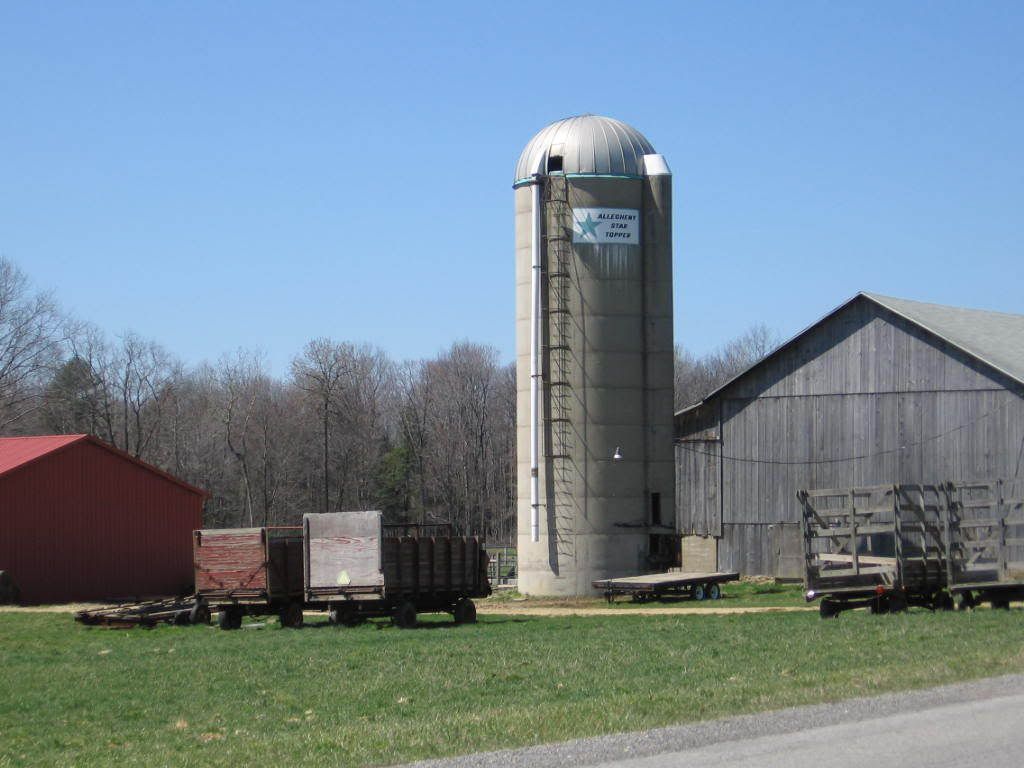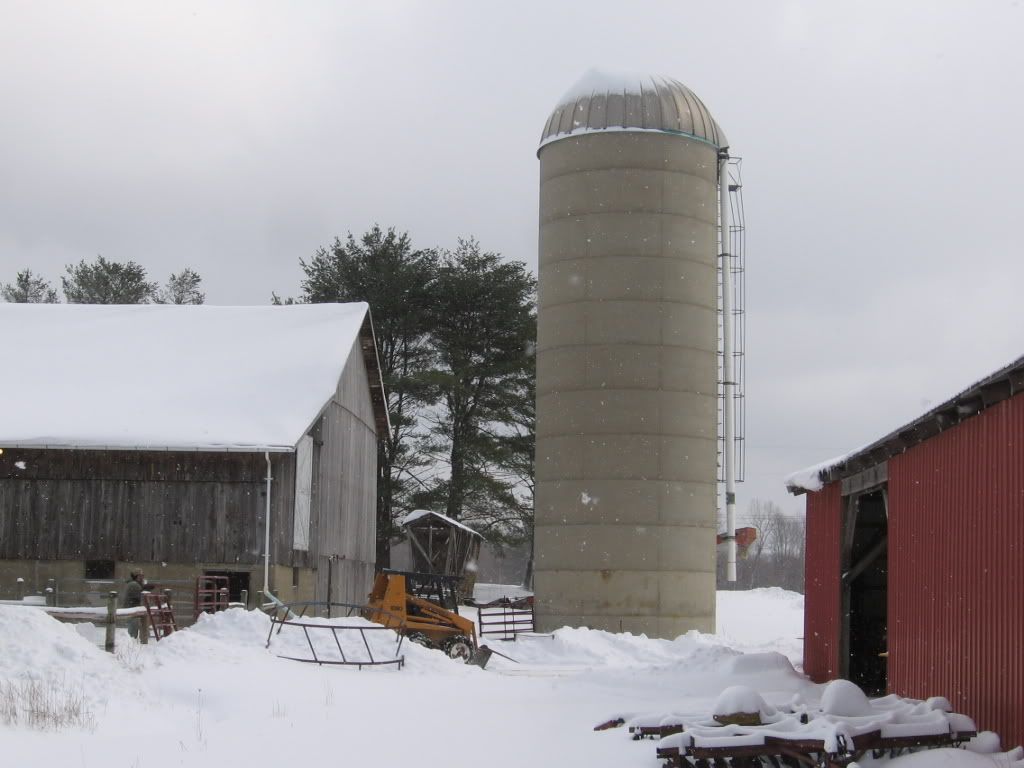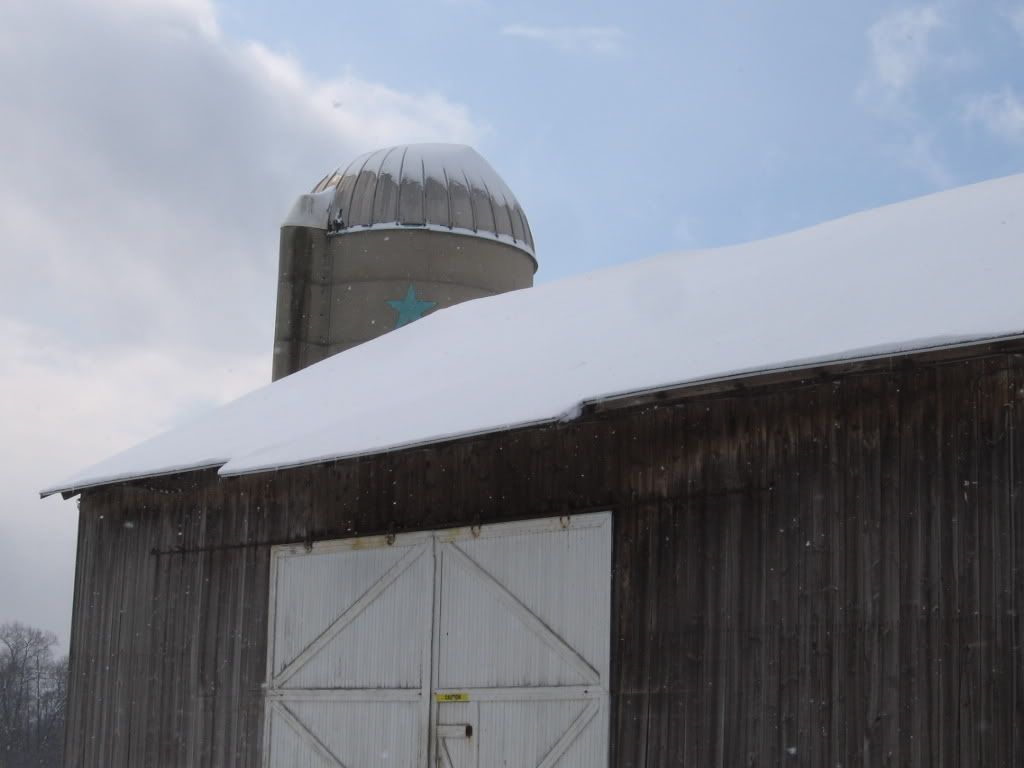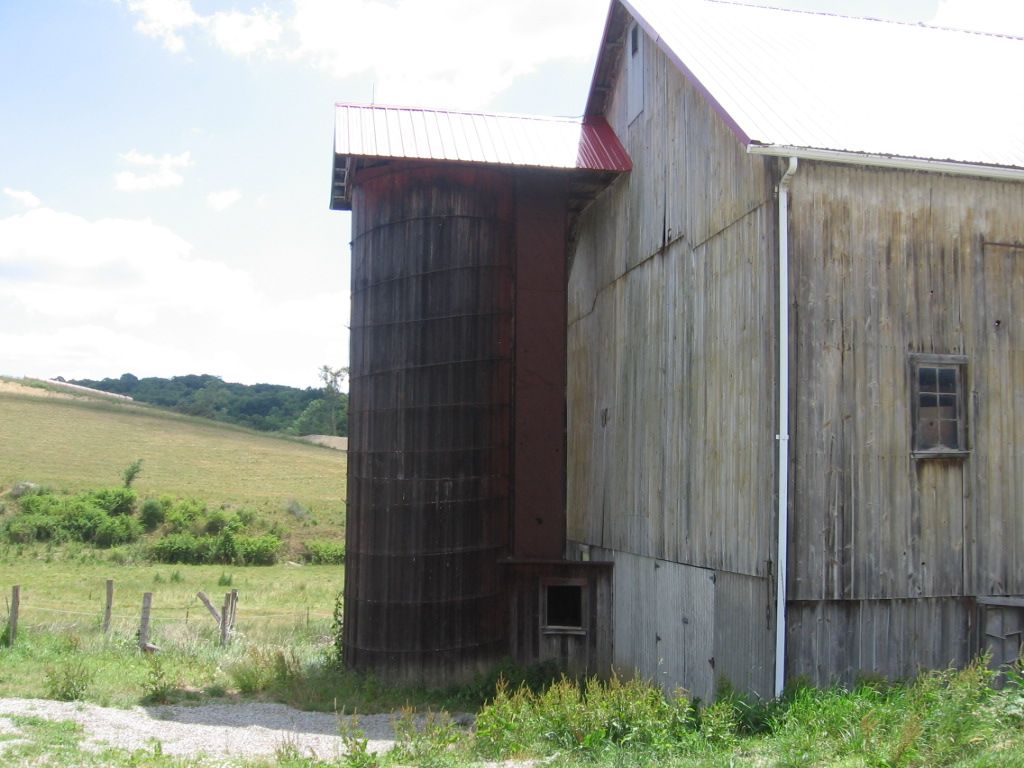I am sure there has been a post like this before. I was wondering who in the forum used pvc pipe to make their grain silos, what size,2". 3" larger? Are there plans somewhere for them? What is the proper height? I was planning on cutting the pipe lengthwise and glueing it agains the wall to save space. I also need and idea of what to use for an office area etc. Thanks again.
Replies sorted oldest to newest
While riding my Harley in the farmland of South Jersey I observe the dairy farm silos. These are small farms. Judging from the tractors and barn near the feed silos, I would guesstimate they are 25' in diameter by 50'-60' feet high. That's near 6" in diameter and 18" high in 1/48. So, I would say sit a cut-off on there and see what looks best visually 'cuz that seems overwhelming .
Like these:
Attachments
Look for posts by Popsrr who has many items made by forum member Alan Graziano.
Thanks DMASSO....I would think it would be fairly easy to do. I can put my air brush to use.
i used sche. 40 pvc pipe 4" diameter that are 24" high for my silos. i didnt have access to5" and 6" looked a bit too big for me.-jim
Thanks mixerman. I am thinking about using the end caps for the schedule 40 for the tops. Need a source for the ladders & detail parts.
I've used 2" pvc for my S Scale grain mill. The silos are about 8.25" high. (Might even finish it one of these days...)
For O. depending on the size of the elevator you're building, you'd probably want to use at least 3" pipe.
Rusty
Attachments
Those blue silos are not for grain, but for silage.
If you want a full O scale Grain Terminal with concrete silos, try 4" PVC pipes at least 25" tall, longer if you want to sink the bottom of the silos into the scenery to anchor them at the foundation.
Andrew
I know about the blue silos we have lots of them around here. Thanks....The grains silos are 100' tall?
I'm a big fan of grain elevators, not so much on the farm silos. PVC pipe is what I'm planning to use. What I've noticed is they use a variety of different diameters. Most are not cylindrical though they appear to be at a glance. I plan to rip the pipe into segments on the table saw, and glue them to a plywood box, paint and detail.
Oh, I see, how the grain silos are different. I recall now about the silage and dairy feed.
So, I searched grain silo photos and came up with these.
I would use metal ducting. 6" for the squat and 4" for the tall. A piece with the seam cut-off and shaped to a circle with a slit would make a nice top. Another 3/4" straight piece could be folded to make the spiral stairs with wire for the railing. Would present the same metal look. Here's one mfg 15'6'' to 105' wide to 115' in height.
What to do with the grain silo when the farmer sells:
Attachments
I usually put kits together. This will be the first time I attempt something scratchbuilt. Not so sure my effort will be worthy. I do know that to save some space I am going to cut the PVC in half to reduce the footprint and do a flat or extended flat for any buildings.
Jim there are several threads on silos here on the OGR. You can find silos made from many materials in real life like Steel, Concrete, Galvanizes ribs, Metal with a variety of liners all depending on the planned use.
Some threads to look at are:
https://ogrforum.com/d...ent/5230909876726300
https://ogrforum.com/d...ent/8891865134063501
https://ogrforum.com/d...ent/9032649517220901
https://ogrforum.com/d...ent/8187868206223362
https://ogrforum.com/d...ent/2415514336577126
https://ogrforum.com/d...ent/6357414879669830
https://ogrforum.com/d...ent/9173459932092595
Here is some pictures of my "pipe" elevators.
Made from 3" pipe and plastic fence post.
Made from 3"plastic pipe and rain gutter down comer pipe. HO windows
The company that built this short elevator in Dodge City, Kansas most of run out of longer plastic pipe. Note size of silos next to size of door in the truck unload room.
Attachments
Jim....
I used standard 4" PVC pipe I purchased from Home Depot to construct my granary. The rest of the structure was made from foamcore. I painted the entire complex an off white and added the details. The nice scale tubing/pipes were hand crafted by Alex (Ingenerio No1). The silos are about 20 inches tall and the entire structure is around 32 inches in height.
Alan
Attachments
This is a continuous cast concrete silo. The dark bands are slip-form marks, and indicates the size of the form used. As the concrete sets, the form is move up, re-inforcement is added, and another casting is done. Construction is done in a couple of days. Ladder, steps, attachments and the chute are all done at the same time. Prior to this, pre-cast concrete or wooden staves and a hoop retaining system were used. This silo is 20' diameter X 50' add the roof. There is an automated unloading system.
This silo replaced two wood stave silos both 10' diameter x 30 ft. One silo dated to the 1930's was dismantled on another farm and re-assembled. The other silo was new 1956. Manual unloading system in both. Was interesting as a young farmboy removing frozen silage. 


I used a heavy wall cardboard tube for a silo. I simulated the riveted plate outer skin with "rivet paper" I drew on my computer and printed out, and glued on using a glue stick. The top cap is cereal box grade cardstock formed into a cone shape, assorted other small details from my never ending scrap box...scratch building is ![]()
Bob
Attachments
I used PVC drain pipe fittings to build the storage tanks on a factory that I built last year.




This farm silo is also built from a piece of PVC drain pipe.



Moonman: have not seen those applications of the metal grain bins before, so thanks
for posting. A farm silo similar to jdcrawler's model pictured above, in rural Shelby County, Kentucky (I'd never find that photo fast) has a little enclosed "treehouse" built on top of it, that I think was lived in at one time. (larger and professionally built). But don't think it has been inhabited for a while, at least in last trips through the area. (probably built for a mother-in-law who has passed on![]() )
)
A book I have on Indiana grain elevators shows at least one now serving as a residence, with modifications. And several fairly recent homes I have blundered on,
including one NE of Lancaster, Pa., but south of the turnpike, on one of the country roads you'd take if you were trying to get to Lancaster from Philly, have incorporated a styled silo into its barnlike architecture, as, to, maybe, enclose a circular stairway to the second floor. (that doesn't count barns with silos converted into residences, or restaurants)
I used PVC drain pipe fittings to build the storage tanks on a factory that I built last year.



This farm silo is also built from a piece of PVC drain pipe.



Ray, those are great looking tanks and silos. What did you use for the silo's section bands?
The PVC pipe for the silo was turned down on a lathe to remove material in-between the "section bands".
Guys some very nice models indeed.
Thanks for mentioning Pop's we will be returning to Silo to production this spring. Likely in the April or may time frame.
Rich thank you for the update.
Yes Rich, thank you for the update.
fellas---nice work!
I used PVC drain pipe fittings to build the storage tanks on a factory that I built last year.

An older wood stave silo. Silage is a wet store product. Can be either grass or corn in most cases. Two things happen, it rots wood and the acidity eats away at concrete. Wood stave silos were either expensive red wood, that inhibited rot, or the wood was creasote treated to inhibit rot. Concrete stave, and eventually cast in place concrete silos, usually had to be treated with an epoxy coating on the inside to inhibit the acidic effects of the silage on the concrete. Nothing last for ever including you and me.

You can also try cardboard tubes (mine were from the center of a roll of greenhouse plastic). I covered the cardboard tube with spackle, and marked it with the putty knife to simulate the markings of poured concrete forms. I added a kitbashed structure to the top which would enclose the conveyor system, and added the front piece a grain elevator kit (which I picked up at York as a seconds). The hardest part of the project was cutting the tubes square. I had problems with both hand cutting and using a skill saw. In the end, I used acrylic calking and spackle to cover up the imperfections, as I couldn't make one truly square cut.
Attachments
For the 'scratchers', here's a couple of helpful products...
http://www.evergreenscalemodels.com/Shapes.htm#Half Round
which can be selectively used for banding or representing weld beading. Solvent bond to PVC.
And...
http://www.micromark.com/o-sca...ce-details,9967.html
which is an easy way to quickly add rivet rows to PVC pipe.
FWIW, always...
KD![]()
BTW...For all you (us) city-slickers who have never seen those blue silos up-close-and-personal, or being erected, did you know that they are built from the top down in the 1:1 world? (Could be a neat mini-scene on the layout farm!) I watched this taking place by the A. O Smith folks about 50 years ago when I did summer work at the Dept. of Agriculture experimental 'farm' in Beltsville, MD. The roof is built first, then raised on jacks to allow the next course of panels to be attached, raised again, etc.. When the last course is attached, they lower the silo to its footing, remove the jacks from inside, bada-bing, bada-boom. Acrophobia not an issue for construction crews.![]() The panels, as I recall, are 'glass-lined'...fiberglass coated, I believe...to tolerate the corrosive nature of silage fermentation heat and chemistry.
The panels, as I recall, are 'glass-lined'...fiberglass coated, I believe...to tolerate the corrosive nature of silage fermentation heat and chemistry.
Just some thoughts about joints both vertical and horizontal.
Some of the silos used on farms are slip formed concrete silos and usually don't have the joints. Joints are not really a good thing to have because of weather and bugs. However eliminating joints can add cost to the owner and eventually to the end user. The large silos that are made up in sections (shop fabricated) with flanges can be more easley brought to a site and can go together quickley. Many of these types use less supporting foundations and structures.
Indusatrial silos used for storage of materials for human consumption, ie Granular Sugar, Salt. Malt,Corn, Rice, Whrat, Barley and various types Flour, are made with GREAT EFFORT to eliminate JOINTS of any kind. However all this can cost time and money and be difficult to transport and errect at the site. The foundations and supporting structure can aslo be costly.
So give thought to what you are modeling and choose your details accordingly.
Just my 2 cents ![]()
Great information!
Silage - I learned a new word today!
Apple & Spud Line....sorry I didn't answer sooner....just haven't been back over here until now. I topped the PVC with foamcore.
Thanks,
Alan
Apple & Spud Line....sorry I didn't answer sooner....just haven't been back over here until now. I topped the PVC with foamcore.
Thanks,
Alan
With just a sketch I emailed him of the area I had available on my layout, which was along a curved section of the double main, Alan (leavingtracks) made this beautiful granary/silo complex for me. It fit perfectly, and it receives lots oohs and aahs from all guests who visit.
Alex
Attachments
Alex...it was a pleasure to build that granary for you my friend!! What really set it off are the detailed handmade brass piping and loading areas made by you. The silver painted details that you made are beautiful!
Alan




























